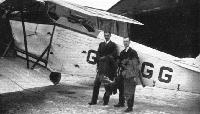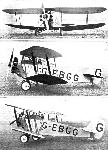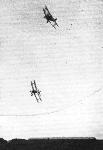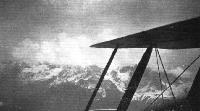
Bristol Type 84 Bloodhound
Одной из целей фирмы "Bristol" при проектировании самолета Type 52 Bullfinch было создание машины, которую можно превратить в двухместный истребитель-разведчик для замены F.2B Fighter. После неудачи с двухместным Bullfinch, самолет F.2B продолжал обеспечивать загрузку производственных мощностей "Bristol" большую часть 1920-х годов. Но еще в октябре 1921 года Министерство авиации выпустило спецификацию 3/21 на самолет для замены F.2B с двигателем Napier Lion. В соответствии с этими требованиями были спроектированы два биплана и один моноплан. Но "Bristol" была против использования "чужого" двигателя и, в конце концов, договорилась с Министерством о создании проекта самолета с мотором Jupiter. Проекты биплана и моноплана, представленные заказчику в мае 1922 года, не имели успеха. Однако в июне 1922 года была выпущена новая спецификация 3/22 на двухместный истребитель с двигателем, оснащенным турбонагнетателем. Наиболее подходящим считался мотор Armstrong Siddeley Jaguar, уже имевший такое устройство. Но глава моторного отдела "Bristol" Рой Федден утверждал, что при использовании в качестве топлива спирта или повышении степени сжатия Jupiter будет развивать такую же мощность до высоты 3050 м при меньших стоимости, массе и сложности силовой установки.
В июле 1922 года "Bristol" представила проекты биплана Fighter "С" и моноплана Fighter "D", а в октябре решила построить биплан в инициативном порядке. Тогда Министерство авиации заказало три прототипа, оснащенных двигателями с турбонагнетателями. Один из них имел цельнометаллический каркас, а у двух других конструкция несущих поверхностей была деревянной и предусматривала замену бипланной коробки на одно цельнометаллическое крыло.
Федден предлагал Уилфреду Рейду, главному конструктору фирмы, использовать двигатель Orion, дальнейшее развитие Jupiter с турбонагнетателем. Этот мотор развивал мощность 400 л.с. (298 кВт) на высоте 4570 м, но до установки его на самолет дело не дошло. В феврале 1923 года проект Fighter "С" получил официальное имя Bloodhound, а позднее - фирменное обозначение Type 84. Прототип совершил первый полет в мае 1923 года, и вскоре его оснастили вертикальным оперением увеличенной площади. В конце июня "Bristol" получила заказ на три Bloodhound для участия в сравнительных испытаниях, проводимых Королевскими ВВС, где их соперниками должны были стать истребители Hawker Duiker, Armstrong Whitworth Wolf и de Havilland Dormouse.
У прототипа Bloodhound имелся ряд незначительных проблем, и Барнуэлл, в октябре 1923 года вернувшийся на фирму, доработал его конструкцию. Была улучшена устойчивость и управляемость машины, а пилот получил больший обзор. Максимальная скорость самолета составляла 209 км/ч, и в январе 1924 года он был передан на официальные испытания. Три Bloodhound, заказанные Министерством авиации, в основном соответствовали по конструкции прототипу.
В отчете испытателей из Мартлешем Хит указывалось, что, хотя Dormouse имел более высокие летные характеристики, Bloodhound отличался великолепной маневренностью и лучше подходил для роли истребителя. Но конструкция из стальных труб была признана неподходящей для серийных самолетов, и дальнейших заказов не последовало. Самолеты затем использовали для участия в гонках и испытаний различных вариантов двигателей Jupiter. Но самым заметным вкладом машины в британское авиастроение стали ресурсные испытания Jupiter, прошедшие столь успешно, что этот двигатель был принят в эксплуатацию компанией "Imperial Airways".
ТАКТИКО-ТЕХНИЧЕСКИЕ ХАРАКТЕРИСТИКИ
Bristol Type 84 Bloodhound
Тип: двухместный истребитель
Силовая установка: один радиальный двигатель Bristol Jupiter IV мощностью 425 л. с. (317 кВт)
Летные характеристики: максимальная скорость 209 км/ч на оптимальной высоте; время набора высоты 3050 м -14 мин 21 с; потолок 6705 м; продолжительность полета 3 ч
Масса: пустого 1141 кг; максимальная взлетная 1921 кг
Размеры: размах крыла 12,24 м; длина 8,08 м; высота 3,25 м; площадь крыла 45,89 м2
Вооружение: два 7,7-мм пулемета Vickers в носовой части фюзеляжа и один 7,7-мм пулемет Lewis на турели в задней кабине
Описание:
- Bristol Type 84 Bloodhound
- Flight, July 1924
THE BRISTOL "BLOODHOUND"
Фотографии
-
Мировая Авиация 75
Регистрационный номер: G-EBGG [15] Увеличив поперечное V крыла и немного отклонив ось тяги двигателя, Барнуэлл сумел существенно улучшить устойчивость и управляемость Bloodhound.
AFTER 25,074 MILES: The Bristol "Bloodhound" in which the "Jupiter" was installed for the endurance tests. This machine, although some three years old, is still going strong, and it is interesting to record that it is the prototype of the latest "Bloodhounds." -
Air Pictorial 1956-05 / Photos by request
Регистрационный номер: G-EBGG [15] BRISTOL TYPE 84 BLOODHOUND - The Bloodhound was an experimental two-seat fighter biplane of composite wood and metal construction. powered by a 436-h.p. Bristol Jupiter V engine. It first flew on 8th June, 1925, and although it did not go into production was subsequently used for various engine tests, and in 1926 made a series of flights between Filton and Croydon totalling 25,074 miles in a flying time of 225 hours 54 minutes, without any engine parts having to be changed. Span, 40 ft.. length, 26 ft. 6 ins. Weight loaded, 4,236 lb. Speed, 122 m.p.h.
-
Flight 1926-02 / Flight
Регистрационный номер: G-EBGG [15] A REMARKABLE ENDURANCE TEST: The Bristol "Bloodhound," fitted with a Bristol "Jupiter" engine, which has been carrying out a series of endurance flights between Filton (Bristol) and Croydon since January 4. So far it has been in the air for 77 hr. 15 min., and has covered 8,595 miles.
-
Flight 1939-03 / Flight
Регистрационный номер: G-EBGG [15] In 1926 a Bristol Bloodhound with sealed Jupiter engine carried out an endurance test of 250 hours without overhaul.
-
Flight 1926-07 / Flight
Регистрационный номер: G-EBGG [15] London-Cairo with a "Jupiter": The Bristol "Bloodhound," Col. Minchin, and Mr. Mayer at Croydon before the flight commenced.
-
Flight 1926-08 / Flight
Регистрационный номер: G-EBGG [15] LONDON-CAIRO WITH A "JUPITER": The Bristol "Bloodhound" at Athens.
-
Flight 1925-07 / Flight
Регистрационный номер: G-EBGG [15] The Bristol "Bloodhound," entered by Sir G. Stanley White, is an all-metal biplane with 400 h.p. Bristol "Jupiter" engine. It will be piloted by Mr. T. W. Campbell.
-
Flight 1924-07 / Flight
Регистрационный номер: G-EBGG [15] The Bristol "Bloodhound" is a two-seater fighter, built entirely of metal. Note the back-swept wings. The engine is a Bristol "Jupiter."
-
Flight 1928-09 / Flight
THE GEARED BRISTOL "JUPITER" AT HOME: The Series VIII geared engine which, installed in a Bristol "Bloodhound" biplane, successfully accomplished a 150-hrs.' flying test
-
Flight 1925-07 / Flight
ONE OF THREE BRISTOL MACHINES ENTERED FOR THE LYMPNE MEETING: The "Bloodhound," with 400 h.p. Bristol "Jupiter" engine.
-
Flight 1940-02 / Flight
Type 84, the Bloodhound, was a high-performance two-seater. 1925
-
Flight 1926-07 / Flight
Регистрационный номер: G-EBGG [15] LONDON-CAIRO WITH A "JUPITER": Filling up with "Shell" at Pisa.
-
Flight 1926-08 / Flight
Регистрационный номер: G-EBGG [15] LONDON-CAIRO WITH A "JUPITER": Left, filling up with "Shell" at Sollum, an operation somewhat difficult of accomplishment, and, right, a first taste of Egyptian coffee.
-
Flight 1926-08 / Flight
Регистрационный номер: G-EBGG [15] London-Cairo with a "Jupiter": Willing helpers haul the "Bloodhound" out of the sand into which its wheels had sunk when alighting at Mersa Mathruh.
-
Flight 1925-07 / Flight
Регистрационный номер: G-EBGG [15] THE KING'S CUP: Some of the first day's starters. 4, T. W. Campbell well away on the Bristol "Bloodhound."
-
Flight 1926-03 / Flight
Регистрационный номер: G-EBGG [15] THE BRISTOL "JUPITER" ENDURANCE TEST: Our photo shows the Bristol "Bloodhound" biplane fitted with a sealed "Jupiter" engine, arriving at Croydon, from Filton, on February 25. Since January 4, when the test started, the machine has been making daily trips between these two points, and no engine replacements have yet been made so far. On Tuesday over 200 hours' flying had been completed and over 22,500 miles flown.
-
Flight 1925-08 / Flight
Регистрационный номер: G-EBGG [15] HEADING FOR POSTLING: The Bristol "Bloodhound," and the Sopwith "Gnu," approaching the aerodrome turning point.
Другие самолёты на фотографии: Sopwith Gnu - Великобритания - 1919
-
Flight 1926-07 / Flight
AN EXTRA TURN AT THE KING'S CUP RACE: An S.E.5 (Savage Sky-Writing) and a Bristol "Bloodhound" put up some smart banking during the impromptu race at Hendon last Saturday.
Другие самолёты на фотографии: RAF S.E.5 - Великобритания - 1916
-
Flight 1926-07 / Flight
London - Cairo with a "Jupiter": A view in the Alps, near the Mount Cenis Pass.
-
Flight 1925-08 / Flight
SOME OF THE LARGER MACHINES AT LYMPNE: From left to right, the Avro-Lynx, Bristol "Lucifer," Bristol "Bloodhound," S.E.5, Sopwith "Gnu," A.D.C.I, and a sky-writing S.E.5.
Другие самолёты на фотографии: Avro Avro 504N - Великобритания - 1920Bristol Taxiplane / Primary Trainer - Великобритания - 1923Martinsyde A.D.C.1 / Nimbus - Великобритания - 1924RAF S.E.5 - Великобритания - 1916Sopwith Gnu - Великобритания - 1919
-
Flight 1927-09 / Flight
TABLE-TOP AERONAUTICS: This is a photograph of Toydon Aerodrome, showing in the foreground an Avro 504K and behind a Bristol "Bloodhound." It is the work of Mr. R. S. Allon of South Woodford, the machines being constructed - with the help of "Flight" scale drawings - to a scale of 1/4 in. to the foot out of cardboard. Unfortunately we cannot recognise the pilot standing outside the "Trust House." Our readers will, we think, agree that it is all quite realistic.
Другие самолёты на фотографии: Avro Avro 504 - Великобритания - 1913
-
Flight 1925-08 / Flight
A FEW DETAILS AT LYMPNE: 3. The unusual aileron crank and pulley arrangement on the Bristol "Bloodhound."
- Фотографии






















